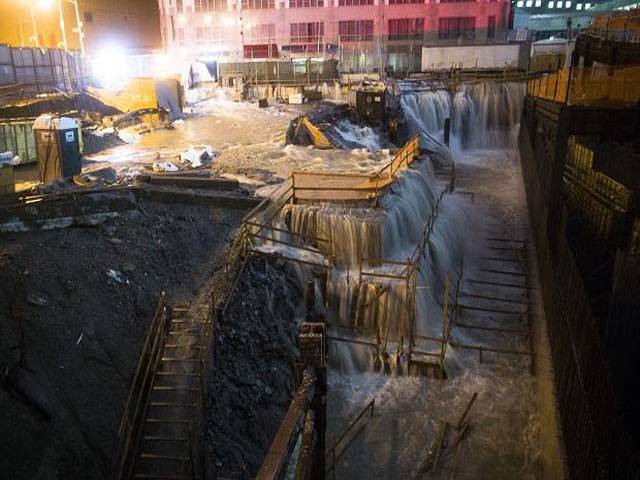Super storm Sandy had crippled downtown New York's transport network and power grid Tuesday after forcing a massive surge of seawater into the streets of lower Manhattan.
The storm -- declared a "major disaster" by President Barack Obama -- left at least one person dead in America's biggest city, while emergency services rescued many people trapped in their homes.
By early Tuesday the storm had weakened and moved inland, leaving large parts of the city swamped and without power, as a massive blaze tore through more than 50 homes in the borough of Queens, according to firefighters.
The water flooded seven underground subway lines, putting them out of action, perhaps for some time.
"The New York City subway system is 108 years old, but it has never faced a disaster as devastating as what we experienced last night," said Joseph Lhota, chairman of the Metropolitan Transportation Authority (MTA).
"Hurricane Sandy wreaked havoc on our entire transportation system, in every borough and county of the region. It has brought down trees, ripped out power and inundated tunnels, rail yards and bus depots," he said.
On Monday, seawater burst the banks of the East and Hudson rivers, submerging road and subway tunnels. Power was cut to about 500,000 homes across New York City's five boroughs, including 250,000 in Manhattan.
Gale force winds pushed over a crane on a skyscraper and tore off the facade of another building.
A falling tree killed a man in Queens, firefighters said. Many people had to be rescued from the upper floors of their homes after ignoring pleas to flee zones at risk from floods, officials said.
"I am seriously concerned for people's lives," Vincent Ignizio, a Staten Island councilor, said Monday. Police appealed for boats to stage rescues on Staten Island and at Coney Island in Brooklyn as the floods slowly receded.
Four other dead were reported in New York state outside the main city.
The hurricane whipped up a record storm surge of 13.7 feet (4.15 meters) and seawater inundated the key Queens Midtown and the Battery Park-Brooklyn tunnels which take traffic from Manhattan Island to nearby suburbs.
The water threatened to engulf the building site at the World Trade Center where the September 11, 2001 attacks took place.
Many cars in the financial district were swamped, some in New York suburbs were swept away, and others were crushed by falling debris.
The Con Edison power company said 500,000 homes in New York City were without electricity. Company vice president John Miksad told reporters it could take a week to completely restore power.
He blamed floods or flying debris for an explosion at a sub-station on the east side of Manhattan's Midtown at the height of the storm. Film of the explosion has been widely viewed on YouTube.
Much of lower Manhattan was blacked out after the power plant explosion. New York University's Tisch hospital had to move 215 patients to other hospitals after it lost power and a back-up generator.
"We went up to 14 foot tides, which no-one was forecasting," Miksad said.
Howling winds of up to 95 miles (150 kilometers) an hour battered the city, pushing over a crane atop a 1,004 (306 meter) luxury apartment skyscraper overlooking Central Park.
The boom of the crane swayed in the fierce gusts and police evacuated surrounding buildings and streets because of the risk that it could fall.
In another spectacular demonstration of its power, the hurricane pulled off the facade of a three-story building in the Chelsea district. No injuries were reported, however.
Tens of thousands of people ignored appeals by the New York mayor to leave districts at risk where police had patrolled the streets calling for inhabitants to take special buses to safety.
Authorities issued a mandatory evacuation order for 375,000 people at risk, but the majority decided to brave it out.
New York state called up 2,100 National Guard troops on Sunday and Monday to patrol threatened districts.
"If water is coming into your home, go to the highest area," New York mayor Michael Bloomberg told a press conference during the worst of the storm.
Bloomberg said the public was making 10,000 emergency 911 calls every 30 minutes and appealed to New Yorkers to not just report power cuts. "It means that genuine emergencies are not being answered," he said.
He also called for taxis to stay off the roads to give priority to emergency vehicles.
The subway was to remain closed on Tuesday, along with schools and public buildings.
Friday, April 19, 2024
Hurricane leaves deadly chaos in New York

8:27 AM | April 19, 2024
8:09 AM | April 19, 2024
President Zardari confers Nishan-i-Imtiaz (M) award on Turkish CGS
8:23 PM | April 19, 2024
NA speaker suspends two MNAs for disruptive behavior during presidential address
8:20 PM | April 19, 2024
PM Shehbaz orders accelerating countrywide drive against smuggling
8:19 PM | April 19, 2024
LHC allows PTI to hold rally in NA-119
8:18 PM | April 19, 2024
Balochistan cabinet members to be assigned portfolios shortly, says CM Bugti
8:17 PM | April 19, 2024
A Tense Neighbourhood
April 19, 2024
Dubai Underwater
April 19, 2024
X Debate Continues
April 19, 2024
Hepatitis Challenge
April 18, 2024
IMF Predictions
April 18, 2024
Kite tragedy
April 19, 2024
Discipline dilemma
April 19, 2024
Urgent plea
April 19, 2024
Justice denied
April 18, 2024
AI dilemmas unveiled
April 18, 2024
ePaper - Nawaiwaqt
Advertisement
Nawaiwaqt Group | Copyright © 2024





